
Olha Hal: “A person who looks at your work should learn something about you from it”
2018
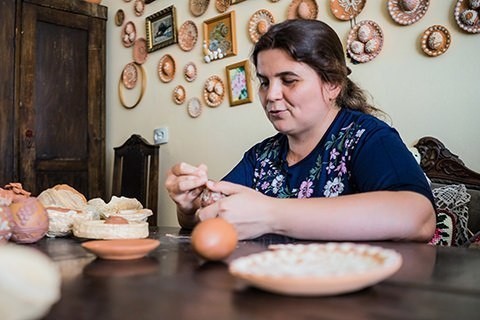
… Her hands turn clay into bright pysanka, plates, decoration items. With a few touches, the artist can turn ordinary raw clay into a festive decorative element. Olha Hal is a member of the National Union of Masters of Folk Art of Ukraine.
She studied at the Uzhhorod School and Lviv Academy of Arts. She is an extremely talented and versatile artist. Her ceramics – a pearl of not only her native Vinohradiv but also the whole region. Her works are original, interesting, full of deep content. And they’re worth talking about them and getting to know the secret of their creation.
"Art is not mathematics! In art, you need to demonstrate your inner state!"
– Olha, tell us please, do you remember the moment when you decided to connect your life with art?
– I'll reveal you the secret that in fact, I’ve never even thought of being engaged in art. In my childhood, I was fully engaged in the educational process. I liked the figures more than some abstract things.
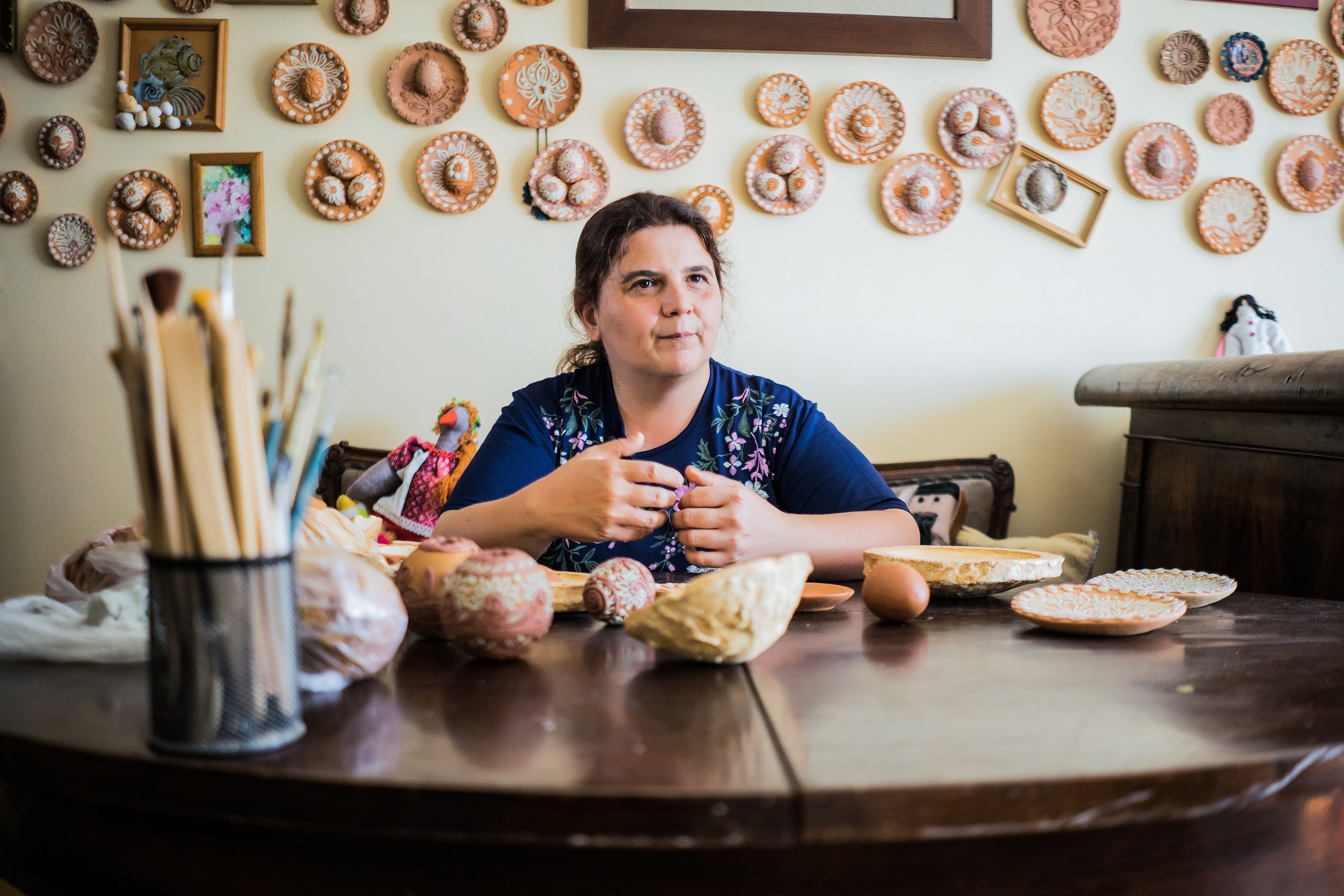
– It is strange to hear today that a person who devoted much of her life to art, in fact, did not want this …
– Nothing strange. In my childhood, I really wanted to study mathematics and physics, but a ceramic plant in Vinohradiv played an important role. My parents decided that the plant could be the best prospect for me since it was not easy to be employed in small district centres. Thus, since the 4th grade, I visited the drawing lessons (my teacher was Petro Kotsan) and spent vacations in the camps “Young Artist” organized by Zoltan Bakoniia. By the way, there was almost the same group of young creative people and then we all studied at the college and Lviv Academy.
– A lot of artists say that it was during the education that they decided on their creative direction. What do you remember about the years of study?
– First of all, the way I got a clear understanding of what art is. For the first time, it was really not easy: mathematical mindset required accuracy, sensitivity, and calculation in art. Accordingly, at the institute, I had a crucial period (Smiles. – Author). I adored math, so I loved to analyse everything, logic and system of numbers. My teachers saw my attitude and one day, they simply “shook” me: why do you keep doing this? Buckle down! Art is not math! It is necessary to think in both fields, but the perception of reality is different. The mathematical representation of reality is a photography. And we need to show the internal state”.
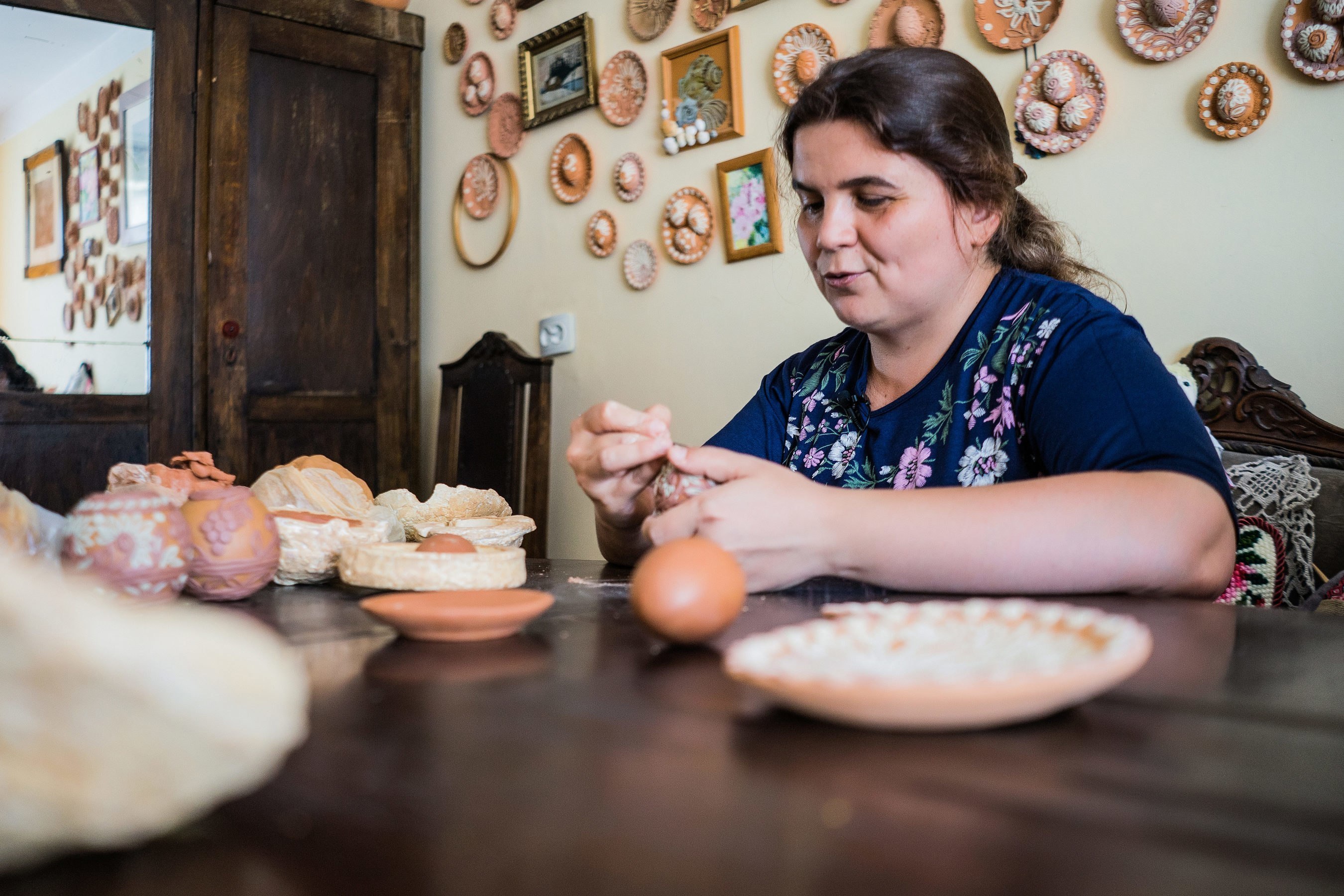
– And you decided to demonstrate it with help of clay?
– In fact, I did not really want to work with clay after graduation, but, as always, a case changed everything. I presented a part of the tea service “Theatre” (a diploma work) at the exhibition, which took place within the framework of the creative report of our district... Among the jury member, there was then an artist, Honoured Master of Folk Art of Ukraine Mykhailo Banyk. He looked at my work and asked: “What do you need for development?” I think, if I say clay, then he will answer to go and dig it myself. So I asked him for a kiln for burning ceramic products, as it cost a lot! However, the artist agreed and this became a significant push to work with ceramics in the future.
– What did you do after graduation?
– Returned to Vynohradiv. I wanted to work at the factory, but it was already closed. At first, I worked at a school of arts, then I was the head of the painting group at the Centre for Out-of-school Work with Children, and at the same time, I was a teacher at a school. Since 2006 – a methodologist at the district department of culture.
“Clay is unique itself, a product forms as it spins on a wheel”
– Do you remember your first works? How did you start?
– I started with making medals at different festivals, honours. In general, I did everything that was possible at home. It was necessary to use clay that I had. (Smiles. – Author)?! And I had a lot of it. My brother helped me to get material! Certainly, I was experimenting. I worked with clay from different places, and as it turned out, they did not interact, because each has its own chemical composition. Accordingly, there were many defects. It seemed quite often that I was wasting time for nothing… But then I calmed down, found my clay and work only with it. I took into account, studied, tested many different nuances and factors. Therefore, now I'm making what I want. By the way, I do not have two identical works, because clay behaves differently. Clay is unique itself, a product forms as it spins on a wheel. And it never fulfils my wishes.”
– So you have a kind of dialogue with clay?
– Perhaps. We teach each other (Laughs. – Author)
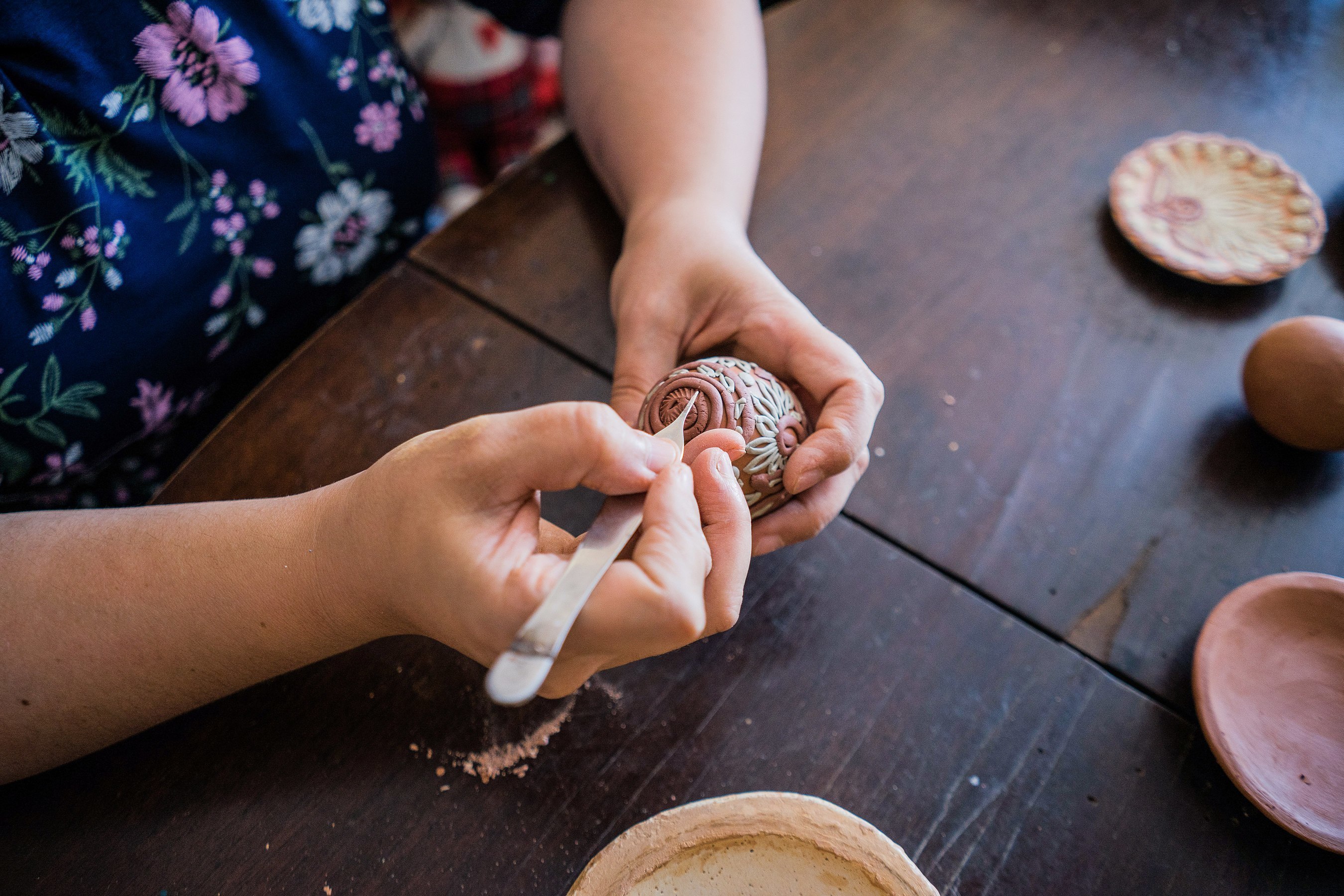
– Your works are incredibly interesting in terms of ornamentation. Where are the ideas from?
– After we “agreed on co-operation”, the question raised, what exactly I should depict on ceramic products. At first, there were patterns of Byzantine and Greek culture. But, frankly, somehow at the local level, they were not taken well, so I decided to search for something else – native, authentic. I thought that there should be some kind of ornament or decor, which would symbolize Vynohradiv district. I studied this question. I had to work with the literature first. For myself, first of all, I was to understand what it had to be. I chose embroidery and models on household things – utensils, towels, tablecloths, folk costumes. Now I stylize these elements of the ornaments and use them in my work – and I am very happy that it looks so harmonious.
– There are bags with material on your balcony instead of household things. Here is clay with a violet tinge, here is yellowish one… Different material – for different products? How do you choose, what to work with?
– In general, I like each colour, but each material with a different shade has its own plasticity, and therefore its character. Often different kinds of clay get apart from each other. As for colour, I prefer natural; I'm not a supporter of adding pigments or something like that. I use the harmony of the natural colour of the material.
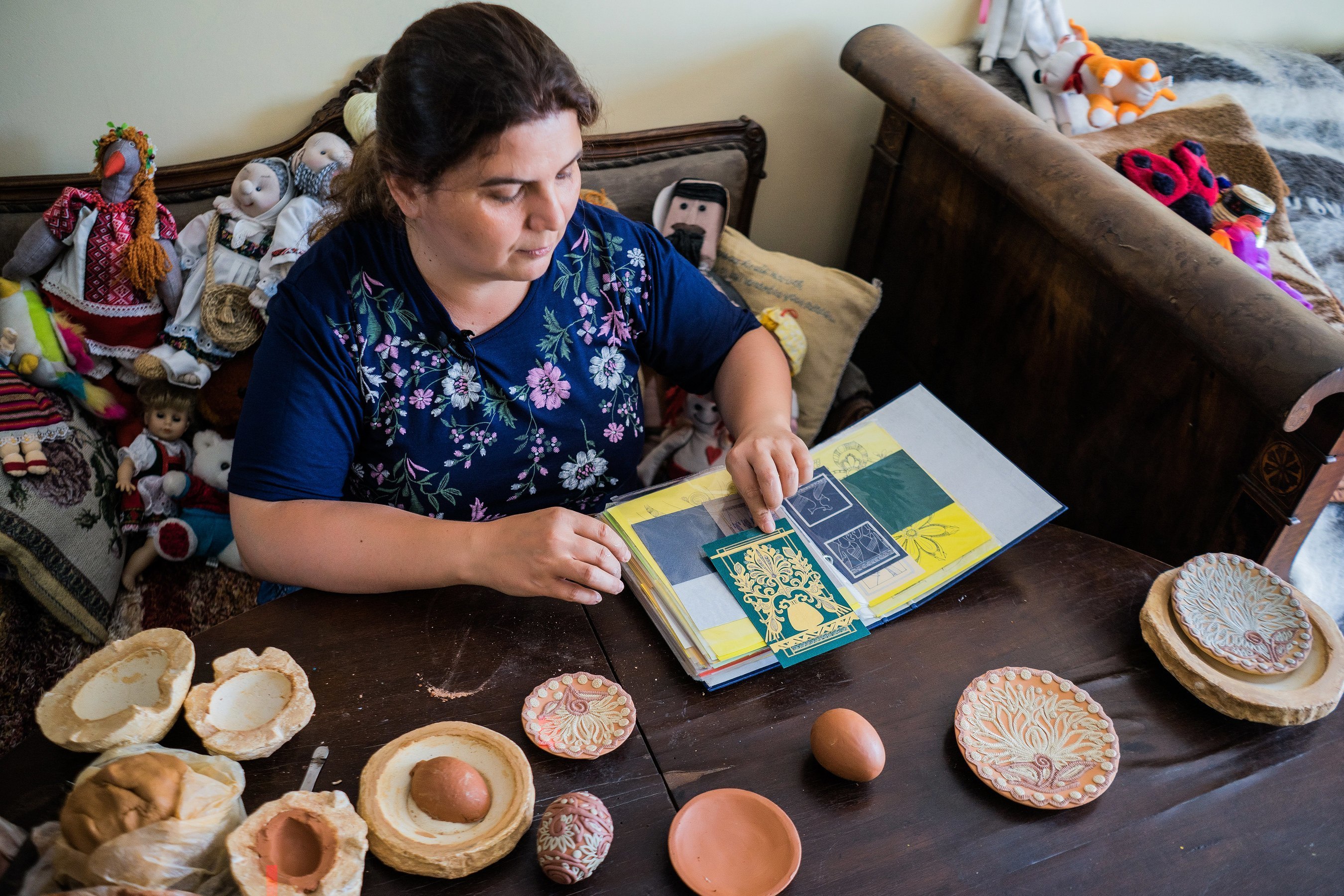
– There are a lot of pysankas in your portfolio and each seems to have a different pattern….
– In general, it rarely happens that I imagine what I want when start working. First of all, I think of the high quality of clay. I feel how slim and handy it when touching it. The product itself is formed by pressing in plaster moulds as an openwork or a continuous layer. Decorative ornament: clay pots on the entire surface of the blade ornamental row, I use embossing with a nail.
Nevertheless, during the decoration, one element leads to another. I have tried different composition patterns of the ornament – along or diagonally on a shape, but the best is to go around. Only then I like what I’ve made. I experiment a lot, I’m in constant search. If a person wants to show something with help of his art, he is looking for ways of expression, and this process can last for a long time.
“A person who looks at your work should learn something about you from it.”
– Olha, you have embroidery, artwork on the glass, and painting on the walls. Is it all the diverse expression of your talent?
– Oh, I had also vytynanky, postcards with flowers – it's a pity there was only a single copy of them, so I cannot donate them to your museum… Later, I transferred those images on the glass: first, a graphics drawing and then I used oil paints. I really liked it. But, unfortunately, such things were not sold very well, a lot of them were gifts, but I needed something to live for … Therefore, flowers eventually turned to clay and came to life on ceramic products.
– Recently, at a collective exhibition in Uzhhorod, I saw your painting. I was surprised because I did not know that Olha Hal is also a painter…
– I have a few paintings, I wanted to try myself in this. Sometimes it's nice to “rummage” in colours, looking for something extraordinary. But… Ceramics is something practical, you can hold it in your hands. Painting is another, a new technique, or a different language. When working with clay it is important to coordinate movements and eyes. In painting, important is perception and vision. I thought about quitting clay and start painting, as it will take less time. But ceramics became very close to me. Painting is yet to be conquered, this is another form of understanding, and ceramics – a known path.

– One more of your hobbies is embroidery. There is probably no such a person in the region that would study and analyse folk’s embroidery more than you!
– Yes, indeed, I was studying the embroidery of my native area and I have samples from almost all of the settlements. Here, I collected everything I could (Olha shows boxes with embroidered shirts, towels, tablecloths, as well as her own embroidery patterns). All the schemes that I managed to find, I studied, disassembled in detail, redrawn. Later I systematized and described everything. I have several publications on this topic in print editions and on the Internet. As for other folk embroidery researchers, they exist! But I would like to say another thing. It hurts that a lot of embroidered objects thoughtlessly disappear or are destroyed! Few people appreciate them. I tell everyone that they were embroidered by your ancestors and there will be no more such samples! Such things need to be appreciated!
Unfortunately, today's youth is not interested in it. Hand-crafted work, filled with folk wisdom, a bearer of the preserved folk traditions, simply disappears.
A person who looks at your work should learn something about you from it, as it was before, but there is less information in the works. As a result, our art becomes silent…
– Olha, is it hard to open the inner world through your works? Communicate with the viewers through such a deep, but very silent kind of art as ceramics?
– It is not hard. The main thing is to have a desire to say something. And if a person is empty inside, then she has nothing to say.
Text: Nataliia Petervari, Denys Fazekash
Photo: Nataliia Pavlyk
